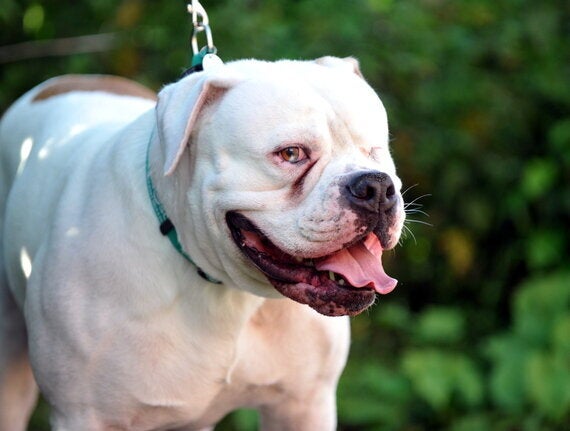With temperatures set to soar in some parts of the UK we all want to get out and enjoy the weather but it's important to remember it's not just us humans who feel the heat.
Sadly, each year we continue to hear devastating stories of dogs being trapped in baking cars, many of whom die as a result. Many people still believe that it's fine to leave a dog in a car if the windows are left open, or they are parked in the shade. But the truth is that leaving your dog in the car for even a few minutes is gambling with their life.
Temperatures can soar quickly inside a car and animals left inside will soon be in distress and can even die.
And it's not just leaving a dog in a hot car that can be a problem. In a recent PDSA case we saved an American Bulldog, Bud, from Liverpool, after he collapsed just yards from his owner's front door following a walk.
Bud had only been out for around 10 minutes when he started struggling to breathe. Thankfully his owner rushed him straight to our Huyton Pet Hospital and he later made a full recovery. But Bud is one of the lucky ones and many pets sadly don't survive heatstroke.

American Bulldog Bud was saved by PDSA vets after suffering heatstroke
Heatstroke can start without warning and can have devastating consequences for our four-legged friends. Dogs can't control their body temperature the way we can. The only way they can try to cool down is through panting and sweat glands in their paws.
Through our pet wellbeing champions, funded by players of People's Postcode Lottery, we're educating owners about the dangers.
One of the most common causes of heatstroke or hyperthermia is dogs that have been left in hot cars. But leaving pets out in the garden for too long without shade or taking them for a walk at the hottest part of the day can be very dangerous too.
Heatstroke advice, causes and symptoms
•Never leave pets in cars, conservatories or caravans even for a short time. Even on a cloudy day with the windows open, the temperature can soar dangerously high in just a few minutes, which can cause fatal heatstroke.
•Try not to exercise pets during the hottest hours of the day. Instead, go out early in the morning or in the evening. Keep strenuous exercise to a minimum and give them access to cool, indoor areas.
•Owners of flat-faced breeds such as Pugs, Boxers and Bulldogs should be particularly vigilant. These dogs often have restricted airways due to their flat-face and don't tolerate heat well. They can show signs of hyperthermia even during a mild increase in temperature and humidity.
•A dog wearing a muzzle will be at high risk because they can't control their body temperature adequately by panting.
•Stressed, over-excited or over-exercised dogs can be at risk even if the temperature and humidity is not excessive, particularly if they are in a poorly ventilated environment.
•Dogs often don't show any warning signs of heatstroke. As the body temperature rises they can pant and drool excessively, become lethargic, drowsy and uncoordinated, and in a short time can collapse, become unconscious, and if not treated as an emergency, it can prove fatal.
What to do if you suspect your pet has heatstroke
You should contact your vet for advice if you are worried any of your pets have heatstroke. For the best chance of survival, pets suffering from heatstroke urgently need to have their body temperature lowered gradually, so:
•Move them to a shaded/cool area.
•Immediately pour small amounts of room temperature (not cold) water onto their body to avoid shock. If possible, you can also wrap them in wet towels or place them in the breeze of a fan.
•Allow them to drink small amounts of cool water.
•Continue to pour small amounts of room temperature water onto them until their breathing starts to settle but never so much that they begin to shiver.
Once your pet is cool, take them to the nearest vet immediately, even if they seem to have made a full recovery.